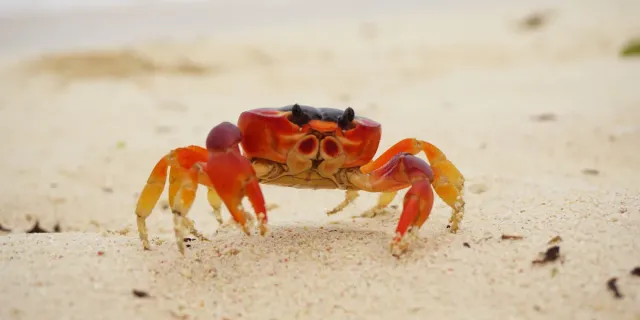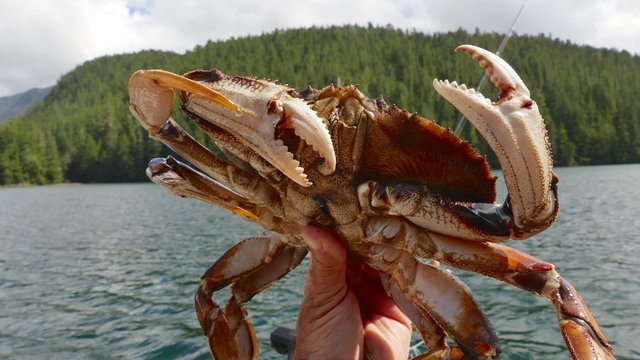Animal Activities #37
When I sit by the beach, most times my eyes catch those small creatures running fast across the sand. Crabs. They look simple but once you start noticing them, you realize their world is never still. In science people call them Brachyura, from Latin which means “short tail,” and that name is not just a fancy title. Their little tail hides beneath the body, pressed flat, covered by the hard shell people call carapax. That shell feels almost like a suit of armor, protecting them from birds above, fish below, and even the strong waves that never seem to rest.
I always look first at the claws. The Latin word is chelae, and it sounds serious, and really it is. Crabs live through their claws. They fight, they grab, they cut, they hold, they even wave them in the air like banners. One day I laughed watching a small crab dragging a half–eaten biscuit across the sand, gripping so tight like it had found a treasure chest. Without those claws, survival is almost impossible for them.
The way they walk also makes me stop and smile. They don’t move straight like most animals, instead they slide sideways. Their legs are fixed in a way that sideways is faster and easier, so they look like little dancers rushing left and right. When danger comes, that side run helps them vanish quickly into the ground. They dig small tunnels, sometimes deep, and you will see tiny round sand balls scattered around. That is the work of a crab pushing sand out, shaping a home, making a place to hide. For me those patterns on the sand look like art.
Food for them is never a big problem, because crabs are omnivora. That Latin word means they eat both plants and meat. Sea-weed, small fish, dead shells, even food scraps that people leave behind, it is also part of their meal. They are most active at night, sneaking out of their burrows when the beach becomes quiet. moving like silent workers, searching and carrying small pieces in their claws.
But their lives are not only about eating. During mating time, males become warriors. They raise their chelae, clashing with rivals, pushing and shoving until one gives up. It looks funny, almost like a tiny boxing fight played on wet sand. The winner earns the space, sometimes the female too. Females carry eggs carefully under their belly in a part called pleon. That is where the little lives stay safe until the time they hatch. When the eggs finally open, the babies don’t look like real crabs. They start as floating larvae drifting with waves, so small you could mistake them for dust in water. Slowly, after changes, they grow into the crabs we see crawling.
Some crabs are not just fighters but also builders. They build and decorate their burrows with shells or most times coral pieces. Maybe it is for safety, maybe! Just maybe it's only for beauty, but I think they care about how their home is and how it looks. They also have this habit of waiting near rocks when the tide is high, holding tight until water drops again. Their lives depends on the ocean, moving with its rhythm, obeying its rise and fall.
People have not ignored them either. Because crab meat is soft, sweet and proteinous, so they became part of our everyday meals long ago. In Latin, the word "cancer" was used to actually describe crab, and the word "Cancer" is still in the zodiac sign today. The symbol of the crab has been linked to protection, and even mystery and persistence too. Ancient people who lived long ago must have watched their sideways walk and strong claws and decided there was meaning hidden in them.
Each time I sit close to the shore, I see how busy they are. Digging, crawling, eating, fighting, carrying eggs, decorating burrows, and always rushing. They might be small, but their life is never slow. They remind me the sea is full of untold stories, and even a tiny crab can show us survival, struggle, and beauty mixed in one. The sand keeps their traces, the water shapes their path, and still they continue, as if nothing in the world can stop their endless work.
I invite @promisezella @etoro @mayjay to participate in this contest
Cc,
@xkool24


Upvoted! Thank you for supporting witness @jswit.
X Entry
https://x.com/Axgustine27/status/1967681459239653732?t=t7xqvP7eWvvJlPpy7hrHdQ&s=19
Los cangrejos son animales muy curiosos , su comportamiento es algo que llama la atención porque cuando están explorando utilizan sus pinzas. Y la capacidad de adaptarse es grande porque pueden vivir tanto en el agua como en la arena